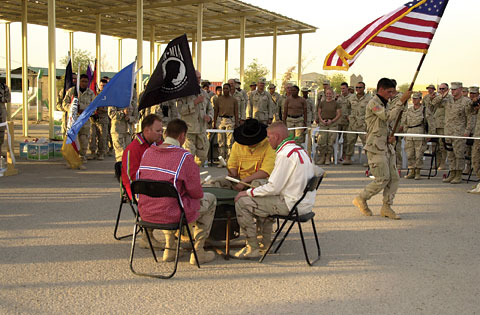 |
|||||||||
|
July/August 2013 Left Behind: Honoring Native American Veterans BY WILLIAM C. TRIPLETT
Specifically, 42,000 Native Americans—one in eight—served in Vietnam, the highest per capita rate of any ethnic group in the United States. In turn, Native Americans suffered the highest per capita rate of wounded and killed. Many of them volunteered, to boot. But in Washington, D.C.—the city of monuments and memorials—nowhere is there anything commemorating the service and sacrifice of the country’s original inhabitants. Bowers, a Seminole Tribe member and a Vietnam veteran of the 173rd Airborne, is hoping VVA and other national veterans service organizations will help change that. “It’s like the saying, ‘Leave no man behind on the battlefield,’ ” Bowers said. “We feel like we’ve been left behind.” In April Bowers appeared before VVA’s Board of Directors to request support for the American Indian Veterans Memorial Initiative (AIVMI), which seeks approval from Congress to establish a national monument to Native Indian, Alaskan, and Hawaiian veterans—and not just of Vietnam. Early in his efforts to launch the initiative, Bowers learned that Native Americans, particularly Indians, had served in every war this country has fought dating back to the American Revolution. AIVMI wants to erect a monument to Native American veterans near the entrance to the education center that is being built near the Vietnam Veterans Memorial on the National Mall in Washington. Persuading Congress to allow such a monument will require a lot of voices.
“It’s a travesty that there’s been no monument,” said Ben Humphries, VVA’s Florida State Council president. “It’s long overdue.” Descended from a Cherokee woman who had been on the Trail of Tears, Humphries shares Bowers’s concerns. He notes that not a single objection was raised by any members of the entire VVA Conference of State Council Presidents when Bowers made his case for support in January. The VVA Board of Directors also responded positively during its April meeting and drafted a resolution endorsing AIVMI. “I think the initiative is awesome,” said Jerry Yamamoto, who chairs VVA’s Minority Affairs Committee. “As a member of a minority myself, I believe we each have values and cultures that add to who and what we all are. Native American veterans really deserve recognition.” Yamamoto, a trained archeologist, has worked on digs examining American Indian sites—particularly cemeteries, where warriors are buried and honored. Support didn’t always come so easily for Bowers, even from American Indian tribes. In its earliest incarnation, AIVMI focused exclusively on getting a statue to honor Indian veterans who had served in Vietnam. “But as I met other American Indian veterans and their families, I’d hear stories about their older relatives who had served in Korea, World War II, and World War I.” The feeling among tribes was that American Indian veterans of all of America’s wars should be honored. Bowers eventually agreed. The initiative had its official start within the Seminole Tribe of Florida, for which Bowers served as liaison to the Florida Governor’s Council on Indian Affairs. The Seminole tribal chair at the time, Mitchell Cypress, a Vietnam-era veteran, endorsed the initiative. Cypress’s successor, current chair and Vietnam veteran James E. Billie, likewise fully supports it.
Still, the task ahead is a big one. As Bowers wrote in an op-ed for the Seminole Tribune in 2011: “I am challenging all veterans organizations, American Indian tribes and tribal organizations and individual Native veterans to march in step with us.” The march had a different destination in the beginning: the site of the famed “Three Servicemen” bronze figures designed by sculptor Frederick Hart and placed near The Wall in 1984. Bowers and others questioned why the three figures that some suggest have implied race/ethnicity—Caucasian, African American, and Hispanic—should not include an American Indian. AIVMI wanted to add a fourth statue representing an American Indian.
VVA declined to get involved. Bowers broadened the initiative to include Native Americans of all kinds—Indians, Alaskans, and Hawaiians—with the emphasis on Native, a moniker that could be claimed only by the oldest of peoples in America. And the AIVMI moved away from adding anything to the “Three Servicemen” sculpture, choosing instead to place a monument—still undecided as to its exact shape and substance—at the entrance of the 35,000-square-foot education center that the Vietnam Veterans Memorial Fund is planning to construct on land across the street from The Wall. While located near The Wall, the new monument would honor the sacrifice of Native American veterans of all wars. This is what Bowers proposed to the VVA Board in April. Here’s the resolution that was drafted: “Vietnam Veterans of America strongly encourages Congress to enact legislation to allow placement of an American Indian/Alaskan Native and Native Hawaiian Statue at the Education Center of the Vietnam Veterans Memorial on the National Mall. This will give the proper recognition to the American Indians/Alaskan Natives/Native Hawaiians who proudly served in the armed forces of the United States, and recognize their sacrifice and service to their country.” VVA’s 2013 National Convention will take place August 13-17 in Jacksonville, Florida, where the resolution will be put to a vote. A vote to accept would formalize VVA’s support for the AIVMI and provide the initiative—and the Seminole Tribe of Florida, which has walked point for recognition of Native American veterans from the beginning—with a significant endorsement. Bowers is optimistic. “I feel really good,” he said. He also plans to seek support from other VSOs. “This is the last significant minority population needing recognition,” said Jerry Yamamoto, “and it’s important we do that because we have a 450-year history of interacting with Native Americans.”
|
|||||||||
8719 Colesville Road, Suite 100, Silver Spring. MD 20910 | www.vva.org | contact us |
|||||||||








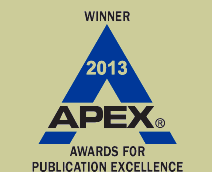
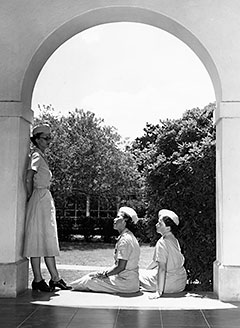 Numbers motivated Stephen Bowers.
Numbers motivated Stephen Bowers.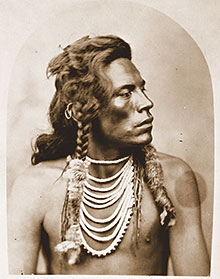 Some VVA leaders are ready to add theirs.
Some VVA leaders are ready to add theirs.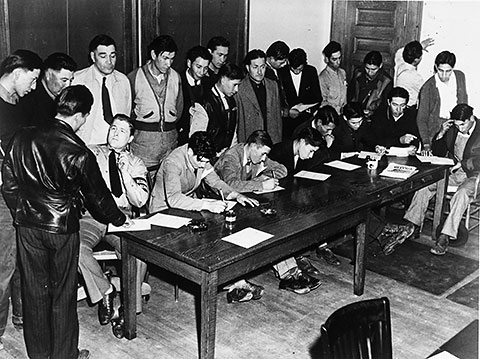
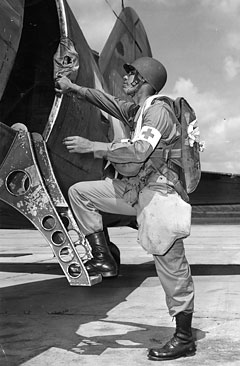 Bowers’s first appeal for VVA support was in 2011 at the National Convention in Reno, Nevada. VVA delegates were not receptive to the original idea, mainly because it raised questions: If an American Indian statue were added to “Three Servicemen,” why not others to, say, Irish-Americans or Japanese-Americans? Plus, it was not clear why Native Alaskans and Hawaiians were not included—weren’t they also Native Americans? Finally, most didn’t want to tamper with such a revered icon.
Bowers’s first appeal for VVA support was in 2011 at the National Convention in Reno, Nevada. VVA delegates were not receptive to the original idea, mainly because it raised questions: If an American Indian statue were added to “Three Servicemen,” why not others to, say, Irish-Americans or Japanese-Americans? Plus, it was not clear why Native Alaskans and Hawaiians were not included—weren’t they also Native Americans? Finally, most didn’t want to tamper with such a revered icon.